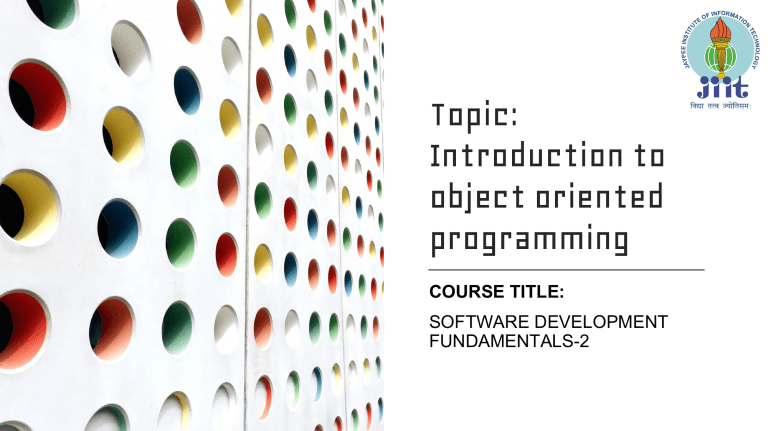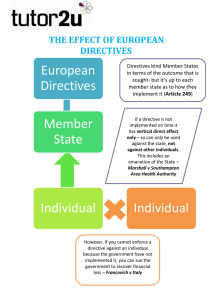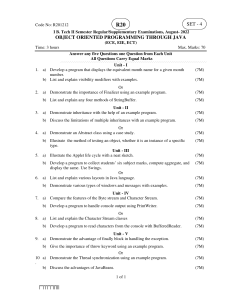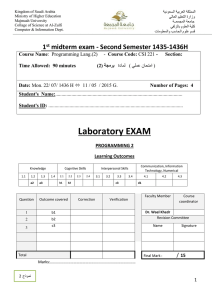
Topic:
Introduction to
object oriented
programming
COURSE TITLE:
SOFTWARE DEVELOPMENT
FUNDAMENTALS-2
1
Course Outcome
Outcomes
Cognitiveof
level
The following are expected outcomes from the students after the completion
this
CO1course,
Explain various object oriented concepts like class and objects, friend
Understand level (Level-2)
function, function and operator overloading etc.
CO2
Apply and implement the relationships of association, aggregation,
composition and inheritance
Apply level (Level-3)
CO3
Analyze the output of source code and able to debug the errors
Analyze level (Level-4)
CO4
Design the class diagram for real life problems and implement it using
virtual functions, abstract classes, templates and exception handling.
Create level (Level-6)
CO5
Apply SQL commands to create tables and perform various operations like
insert, delete, select etc.
Apply level (Level-3)
2
Assessment method
External Assessment –
◦ T1
◦ T2
– 20 Marks
– 20 Marks
◦ End Semester Exam
– 35 Marks
Internal Assessment
◦ Tutorial Assignments
- 5 Marks
◦ Mini-project
- 10 Marks
◦ Attendance
- 10 Marks
3
Basic structure of C++
▪ C++ program has following sections in its basic structure,
▪ Directives/libraries inclusion section
▪ Main function section
▪ Function body section
▪ Directives inclusion section allows to include the required libraries for the program.
▪ Main function section defines the sequence of code that has to be executed.
▪ Function body section defines the functionality of the functions. It has declaration and
executable statements.
4
Basic structure of C++
#include <directives>
Directives inclusion section
using namespace std;
int main()
{
Declaration statements
Executable statements
Function body section
Main function section
return 0;
}
5
Basic structure of C++
#include <directives>
It includes the directives/libraries mentioned in angle brackets
using namespace std;
int main()
{
Declaration statements
Executable statements
return 0;
}
6
Basic structure of C++
#include <directives>
using namespace std;
This statement informs compiler to use std namespace in which the
standard C++ libraries are declared.
int main()
{
Declaration statements
Executable statements
return 0;
}
7
Basic structure of C++
#include <directives>
using namespace std;
int main()
Main function definition part.
{
Declaration statements
Executable statements
return 0;
}
8
Basic Input/Output in C++
The following are operations used for input and output in C++,
S. No.
Operatio
n
Purpose
1
cout
Standard Output stream
2
cin
Standard Input stream
3
cerror
Standard error output stream
4
clog
Standard log output stream
9
Basic Input/Output in C++
▪ cout basically outputs stream on console.
▪ cerror is used to output error messages on standard console.
▪ clog directs the log messages to standard console output.
▪ cerror and clog can be redirected to another output stream.
Output in C
Output in C++
printf(“%d”, x);
cout<<x;
printf(“Hello World”);
cout<<“Hello World”;
printf(“The average is %f”, avg);
cout<<“The average is ”<<avg;
printf(“\n”);
cout<<endl;
10
Basic Input/Output in C++
▪ cin basically inputs stream and directs to the variable.
Input in C
Input in C++
scanf(“%d”, &x);
cin>>x;
scanf(“%s”, str);
cin>>str;
scanf(“%d %s”, &num, str);
cin>>num>>str;
11
References
▪Herbert Schildt, “C++: The complete reference”, Mc Graw Hill Osborne media, 4th
edition, 2017
▪Robert Lafore, “Object oriented programming in C++”, SAMS, 4th edition, 2002
12




